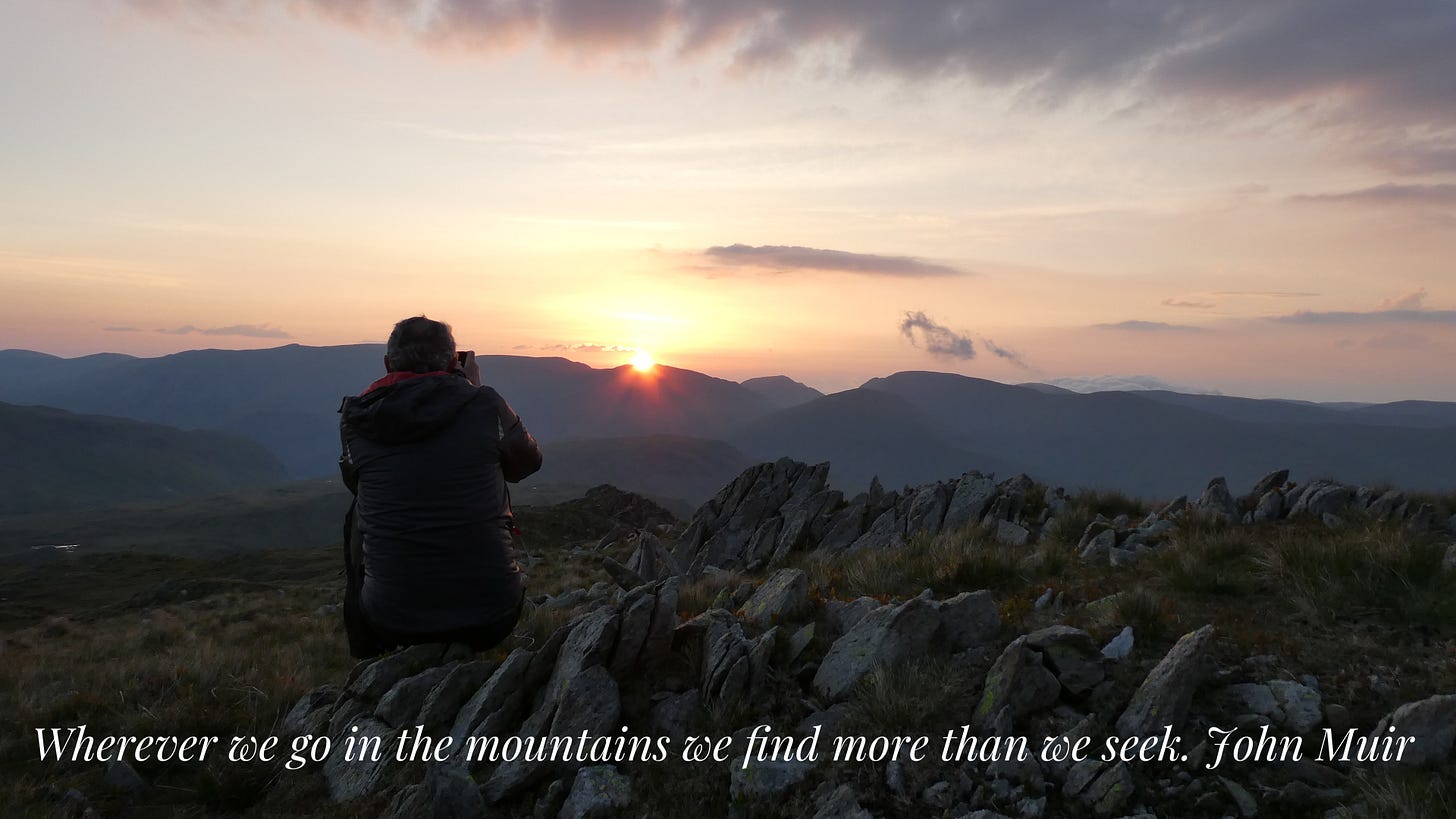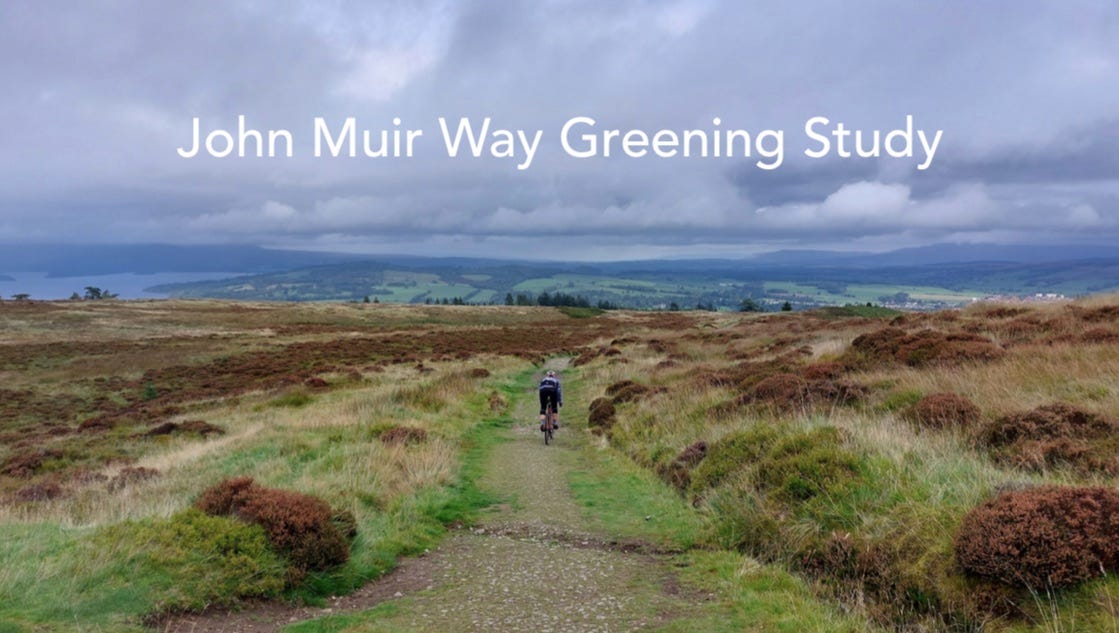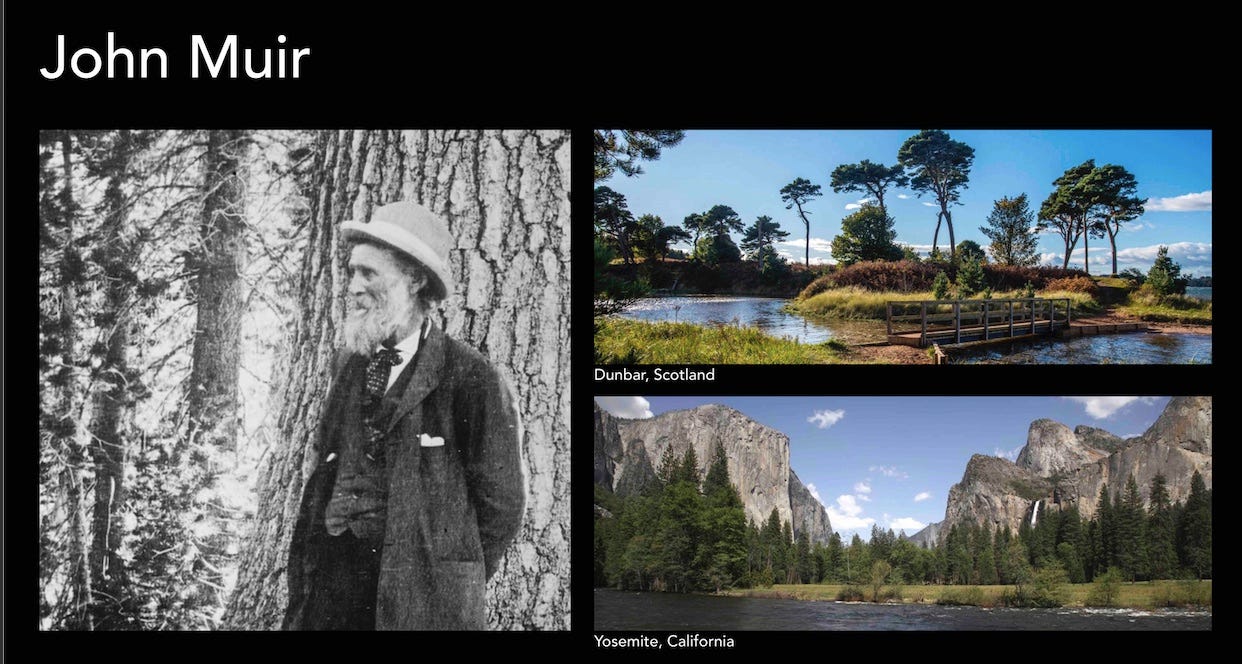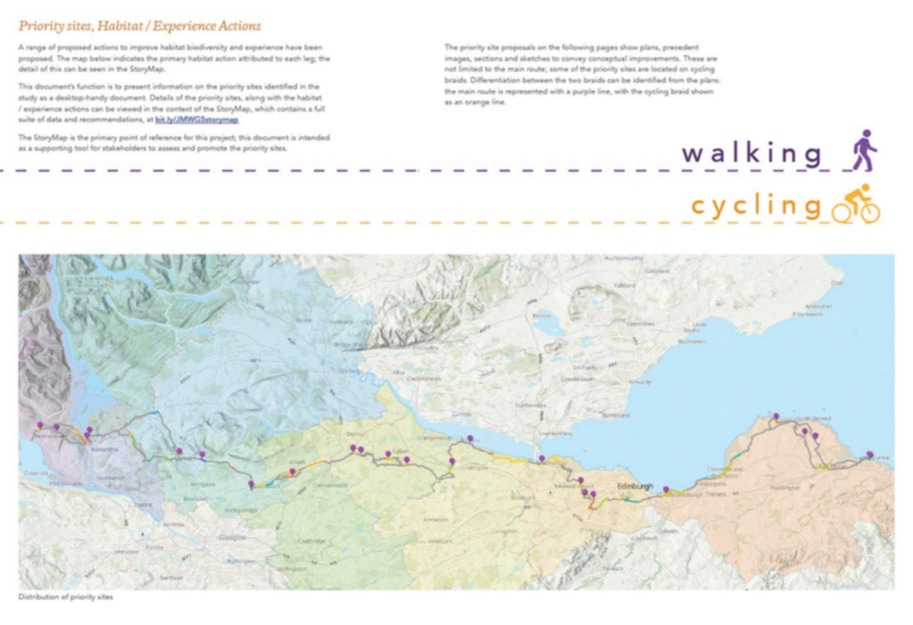John Muir Way's Greening Study, Gilbert White's Nature Diaries, Aliveness + Regenerative Business
Connecting with Nature, Zoom Regenerative 54, Oozing Aliveness and Regenerative News
Hello and thank you for reading this edition of Regen/Notes1
For the Zoom Regenerative edition 54, Sam Shaw (at RaeburnFarquharBowen) shared insights from the John Muir Way greening study, a project aimed at promoting ecological and placemaking improvements to enhance the trail’s impact for both nature and people. The project was recognised with a Landscape Institute Award in 2022 for for Excellence in Visualisation and Digital Practice.
Sam drew a connection between John Muir’s upbringing in Dunbar, Scotland and his interest in safeguarding important landscapes, such as Yosemite National Park in America. Muir’s views on nature can be applied to both places despite the vast difference in scale between Dunbar and Yosemite. The discussion highlighted the importance of environmental consciousness and the impact of personal experiences on one’s perception of landscape architecture.
“keep close to nature’s heart, break clear away, once in a while, and climb a mountain or spend a week in the woods, wash your spirit clean,”
Sam cited Muir’s famous quote, “keep close to nature’s heart, break clear away, once in a while, and climb a mountain or spend a week in the woods, wash your spirit clean,” as an example of the importance of experiencing nature firsthand. The John Muir Way, a 134-mile walking / cycling trail in Scotland, seeks to do just that by promoting ecological and placemaking improvements to enhance the trail’s impact.
The Greening Study, funded by the Scottish government and other organizations, consulted with local authorities and stakeholders to address environmental and community inequalities and promote biodiversity, habitat connectivity, and landscape improvement projects. Engaging communities and volunteers in route management and maintenance is also a key part of the John Muir Way’s strategic aims.
The John Muir Way project aimed to improve the greenery and active travel network of the CSG by increasing carbon activity, supporting invertebrates, improving green spaces and targeting areas of environmental disadvantage. The project’s GIS website allows users to navigate each local authority area and prioritise sites, which include flood prevention areas, low intervention routes, and field paths that could improve the experience for both nature and people.
Some ‘legs’ of the John Muir Way required no improvement, while others had the potential for massive change. Priority sites were developed to act as a catalyst for significant change or provoke people to reconsider the norms. These priority sites were spread equally along the route to ensure each local authority had at least one. One of the priority sites was at Queensbury under the Forth rail bridge, which as a four lane car park was considered an eyesore environment. Sam and team also utilised resources such as a storymap & video guide with a radio voice and a little forward by Rory McCraw to boost their message.
During the regenerative discussion that followed, the importance of community and individual action in making positive environmental change was emphasised. The idea of greening of one place at a time to save the planet, as advocated by Bill Reed from Regenesis, was highlighted. The use of story maps and GIS information was discussed as a way for communities to take action.
Additionally, the conversation touched on the need for a respectful relationship with nature, echoing the views of naturalist Gilbert White and attention to detailed observing and experiencing nature in a humble manner.
Gilbert White recorded nature diary entries daily from 1751 to 1793. As Richard Maybe commented in the Introduction to Gilbert White’s Year, White saw the diaries as his intellectual ledger where he took stock of his understanding of the world around him.
From Gilbert Whites Year Journal April entries … Green wood-pecker laughs at all the world. Storm-cock sings (1770) Wood lark sits, Swallow comes early. Is the latter sound ventriloquous or from rapid motion of the wings? (1772) Searched the SE end of the hanger for house-martins but without success tho’ many a young men assisted. (1781) Snow hangs in the trees & makes a perfect winter scene (1785)
The Next Zoom Regenerative
Following on from the last zoom regenerative we stay in Scotland for ZR55 to hear from Dr John Ennis sharing insights from his work at Journeys in Design. Tuesday 25th April 2023.
Oozing Aliveness - In the Flow
The last Regen Notes post (Bringing Nature Inside) cited the work of Charles Eisenstein and how the digital world is replacing our senses, furthering our separation from the natural world, replacing aliveness with preservation, replacing our wild thoughts with formulas and our adventures with simulations.
I was reminded of this whilst currently reading Amy-Jane Beer’s book, The Flow: Rivers, Water and Wildness and that our adventures don’t need to be simulated or our wild thoughts replaced with formulas. Amy-Jane then popped up with a feature on the brilliant Folk on Foot podcast series hosted by Matthew Bannister, walking along the River Clettwr in Wales with Welsh singer and songwriter Owen Shiers - and then again as Guardian Country Diary(ist) this week, wild swimming in the Wharfe in the Yorkshire Dales. (I swim on behalf of the life in this river) - Simply oozing aliveness.
News that resonates well with Regen Notes …
Let's talk about 'regenerative business' not sustainability: The World Economic Forum (WEF) reports on concerns that the current boom in sustainability and net-zero commitments may not be enough to combat the vast social, environmental and economic challenges, a “system-wide crisis” we now find ourselves in. WEF recognises We need a paradigm shift and take a regenerative approach to business that promotes the restoration and regeneration of natural resources and social systems. It goes beyond sustainability and seeks to create positive impacts on the environment, society and economy.
This approach requires a fundamental shift in business practices and is integral for any organization with ambition for positive impact and growth. Until now, organizations have predominantly focused on their carbon footprint as a metric, which is too narrow to capture the breadth of issues in our current economy.
Rewilding Could Help Limit Warming Beyond 1.5°C - According to a study published in the journal Nature Climate Change, rewilding, or preserving and restoring wildlife and wilderness areas, could improve natural carbon sinks in ecosystems, therefore boosting natural methods of carbon capture and helping the world limit global warming to 1.5°C above pre-industrial levels. Source Eco watch
Another report showing Humanity needs to fundamentally change its relationship with nature in order to protect wildlife and enhance the environment. That is the verdict from a milestone report published this week by the European Environment Agency. Featuring expert insight from one of Reading's top environmental scientists, "Exiting the Anthropocene? Exploring fundamental change in our relationship with nature" is the latest in a series of studies that aim to trigger change in the way we think and act towards sustainability (Source)
Supporting Regen Notes
Now in its third year, Regen Notes has been bringing regenerative news and thinking, (mostly around our separation and reconnecting from nature), to hundreds of regular readers. I make free and paid subscribers' content the same with a few exceptions. Paid is to show a little appreciation, encouragement and support. I am in debited to those who support through subscriptions.
And, or if you maybe enjoyed this edition, you could simply buy me a coffee. Thank you.
Previous articles on Regen/Notes can be explored here - and the best of 2022 can be read here- ENJOY.








![The Flow: Rivers, Water and Wildness by [Amy-Jane Beer] The Flow: Rivers, Water and Wildness by [Amy-Jane Beer]](https://substackcdn.com/image/fetch/$s_!nrMa!,w_1456,c_limit,f_auto,q_auto:good,fl_progressive:steep/https%3A%2F%2Fsubstack-post-media.s3.amazonaws.com%2Fpublic%2Fimages%2Ffb984cd4-e05c-48c7-be21-27e40759bf0e_311x500.jpeg)